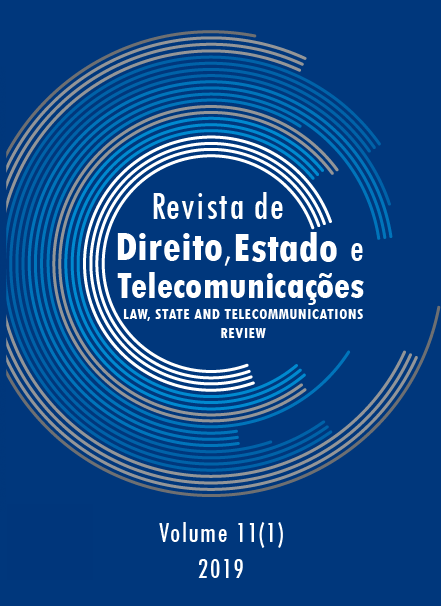Technological Infrastructure and Data Access in Police Districts: An Evaluation of the ICTs Use Against Crime in Lima, Peru
DOI:
https://doi.org/10.26512/lstr.v11i1.24849Keywords:
ICT. Criminality. Technological infrastructure. Police districts. Peru.Abstract
Purpose ”“ With the rapid growth of cities, the functions of the police have been affected. The increase in the use of Information and Communication Technologies (ICT), backed by access to a large amount of public and police information, represents an opportunity for improving the fight against crime and to manage time more efficiently.
Methodology/approach/design ”“ This paper analyzes the role played by ICT as tools for reducing crime in the city of Lima (Peru).
Findings ”“ The results obtained show that a better level of ICT infrastructure and greater access to information sources through the Internet in police stations discourages the level of crime.
Practical implications ”“ In addition, these better levels of ICT presence in police stations generate a higher level of interaction and exchange of data and information between neighboring police stations.
Downloads
References
Aguirre, J. (2016). La tecnología de información y comunicación en prevención del delito. Revista Latinoamericana de Estudios de Seguridad, Nro. 18, pp. 90-103.
Angrist, J. & Krueger, A. (2001). Instrumental variables and the search for identification: From supply and demand to natural experiments. Journal of Economic Perspectives, Vol. 15, Nro. 4. Pp. 69-85.
Ayres, I. & Levitt, S. (1998). “Measuring Positive Externalities from Unobservable Victim Precaution: An Empirical Analysis of Lojack”. Quarterly Journal of Economics, February 1998, 113(1), pp. 43”“77.
Becker, G. (1968). Crime and punishment: An economic approach. Journal of Political Economy, Vol. 76, pp. 169-217.
Benito, J. & Cervantes, D. (2017). Mejora del sistema SIDPOL para la Policía Nacional del Perú. Universidad Peruana de Ciencias Aplicadas (UPC).
Boondao, R.; and Tripathi, N.K.; (2007), “Electronic Policing: A Framework for Crime Control and Citizen Services”. In: Social Implications and Challenges of E-Business Edited by Feng Li. IGI Global. pp. 78-93.
Busagala, L. & Ringo, J. (2013). Constraints of E-Policing Adoption: A Case of Dodoma, Tanzania. International Journal of Information and Communication Technology Research, Vol 3, Nro. 1, pp. 42- 48.
Cracolici, M. & Uberti, T. (2008). Geographical Distribution of Crime in Italian Provinces: A spatial Econometric Analysis.
De Paula, A. (2015). Econometrics of Networks Models. No CWP06/16, CeMMAP Working Papers, Centre for Microdata Methods and Practice, Institute for Fiscal Studies
Di Tella, R. & Schargrodsky, E. (2004). “Do Police Reduce Crime? Estimates Using the Allocation of Police Forces after a Terrorist Attack”. American Economic Review, Nº 94: pp. 115-133.
Duggan, M. (2001). “More Guns, More Crime”. Journal of Political Economy, 109(5), pp. 1086”“1114.
Gorr, W. & Kurland, K. (2012). GIS Tutorial for Crime Analysis. Redlands, California: ESRI Press.
Instituto Nacional de Estadística e Informática (INEI). (2014). Una mirada a Lima Metropolitana.
Instituto Nacional de Estadística e Informática (INEI). (2016). Estadísticas de las Tecnologías de Información y Comunicación en los Hogares, Octubre-Noviembre-Diciembre 2015. Informe Técnico Nro. 1.
Koper, C.., Taylor, B., & Kubu, B. (2009). Law Enforcement Technology Needs Assessment: Future Technologies to Address the Operational Needs of Law Enforcement.
Kovandzic, T., Schaffer, M., Vieraitis, L., Orrick, E. & Piquero, A. (2015). Police, Crime and the Problem of Weak Instruments: Revisiting the “More Police, Less Crime” Thesis. Journal of Quantitative Criminology, Vol. 32, Nro. 1, pp. 133-158.
LeBeuf, M. (2006), “E-Policing in Police Services -Definitions, Issues and Current Experiences”. The Royal Canadian Mounted Police, Canada. ISBN 978-0-662-46262-0.
Lochner, L. & Moretti, E. (2003). The effect of education on crime: Evidence from prison inmates arrests, and self-reports. The American Economic Review, Vol. 94, Nro. 1, pp. 155-189.
Ogunbameru, O. (2008). Sociological theory, Penthouse publications, Nigeria.
Manski, C. (1993). Identification of Endogenous Social Effects: The Reflection Problem. The Review of Economic Studies, Vol. 60, Nro. 3, pp. 531”“542.
Mendonça, S., Crespo, N. & Simões, N. (2015). Inequality in the network society: An integrated approach to ICT access, basic skills, and complex capabilities. Telecommunications Policy, Vol. 39, pp. 192”“207.
Ministerio del Interior del Perú (MININTER). (2013). Evaluación de diseño y ejecución presupuestal de seguridad ciudadana-policía nacional del Perú.
Paynich, R. y Hill, B. (2010). Fundamentals of Crime Mapping. Sudbury, Massachusetts: Jones and Bartlett Publishers.
Silverman, E. (2002). El programa CompStat y la policía del distrito de Nueva York. Revista Catalana de Seguretat Pública, Nro. 10, pp. 41-46.
Swimmer, G. (1974). The relationship of police and crime ”“ Some methodological and empirical results. Criminology, Vol. 12, Nro. 3, pp. 293-314.
Vázquez, C. y Soto, C. (2013). “El análisis geográfico del delito y los mapas de la delincuencia”. Revista de Derecho Penal y Criminología, Nro. 9, 419-448.
Webster, C. & Kingston, S. (2014). Poverty and crime. Londres: Joseph Rowntree Foundation.
Wessels, B. (2009). Information and Communication Technologies and Policing: The Dynamics of Changing Police-Public Communication in the East End of London. The Howard Journal, Vol. 48, Nro. 5, pp. 501-513.
Worrall, J. & Kovandzic, T. (2010). Police levels and crime rates: An instrumental variables approach. Social Science Research, Vol. 39, pp. 506-516.
Zhao, H., Feng, Z. & Castillo-Chávez, C. (2014). The dynamics of poverty and crime. Journal of Shanghai Normal University, Vol. 43, Nro. 5, pp. 486-495.
Downloads
Published
How to Cite
Issue
Section
License
By submitting this paper to the Law, State and Telecommunications Review,
I hereby declare that I agree to the terms of the Creative Commons Attribution 4.0 International (CC BY 4.0).


